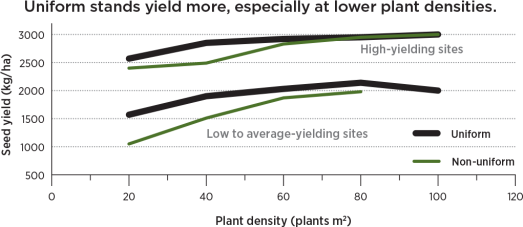Aim for uniform stands
Key practice: Uniform stands, with the same number
of plants per square foot across the field and with plants at the same growth stage, are proven to increase yields.
Key research: Angadi, S.V., Agriculture and Agri-Food Canada (AAFC), et al. “Yield Adjustment by Canola Grown at Different Plant Populations under Semiarid Conditions.” Crop Science 43 (2003): 1358-1366.
Gan, Yantai, AAFC. “Improving Canola Establishment and Uniformity Across Various Soil-Climatic Zones of Western Canada.” Canola Digest Science Edition (2013).
Yang, C., Gan, Y., AAFC, et al. “Up to 32% Yield Increase with Uniform Canola Stands in Western Canada.” Agronomy for Sustainable Development (2014).
Canola stands with a consistent number of plants per square foot across the field and with plants at the same growth stage produce significantly higher yields. The benefit of a uniform stand is especially evident when overall plant populations are less than ideal or when moisture is limited.
Chao Yang and Yantai Gan of Agriculture and Agri-Food Canada (AAFC) et al published a March 2014 paper in Agronomy for Sustainable Development titled, “Up to 32% Yield Increase with Uniform Canola Stand in Western Canada.” The paper details a three-year Canola-Flax Agri-Science Cluster study in which field experiments were conducted at 16 site-years across the different Canadian Prairie zones to review the impact of stand uniformity on canola pod formation, seed set and crop yield. Each test consisted of the same glufosinate-resistant hybrid cultivar sown at 100, 80, 60, 40 and 20 plants per square metre (approximately 10, 8, 6, 4 and 2 plants per square foot) with both uniform and non-uniform stands.
Yang and Gan found that spatially uniform stands increased seed yield by up to 32 percent at low-yielding sites and by up to 20 percent at high-yielding sites (see the figure). Ensuring a uniform growth stage will improve the ability to time in-crop applications and harvest to optimize both crop quality and yield. Yang and Gan conclude, “…canola yield can be increased by improving the uniformity of plant spatial distribution patterns in the field regardless of environmental conditions.”
“Yield Adjustment by Canola Grown at Different Plant Populations under Semiarid Conditions,” published by S.V. Angadi in Crop Science (2003), reports similar results from a 1999 to 2001 field study at Swift Current, SK. Here it was found that even reducing plant population by half from 80 to 40 plants per square metre, which is just below the recommended minimum for optimum canola yield potential, did not reduce seed yield when the reduced plant population was uniformly distributed. However, seed yield at this lower density was significantly reduced by non-uniform distribution.

How to improve uniformity
A number of factors contribute to poor uniformity in canola plant stands, including uneven seeding depth, insect damage, excessive seed-placed fertilizer, late spring frost or other environmental conditions, and improper management of previous crop residues.
For uniform stand establishment under a wide variety of conditions, use a seeder that can consistently place seed 1.25 to 2.5 cm (1/2″ to 1″) deep. The seeding tool has to be set properly for a grower to achieve the target seeding depth and seed-to-soil contact for all seed rows.
Slowing down while seeding allows for accurate seed placement and consistent seeding depth, resulting in more uniform emergence. Ideal speed varies by the type of drill, soil type and moisture, as well as amount and type
of crop residue. It is important to find a seeding speed that is right for both the equipment and conditions. •




